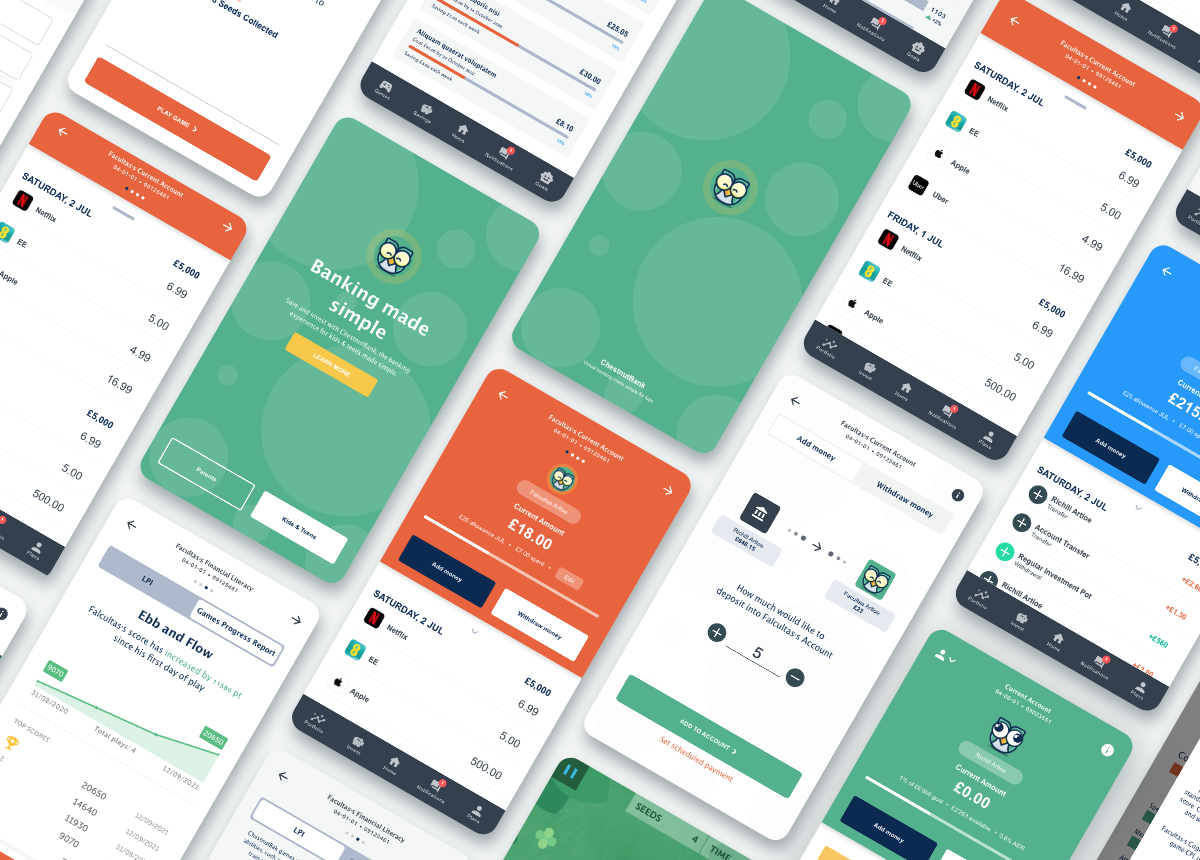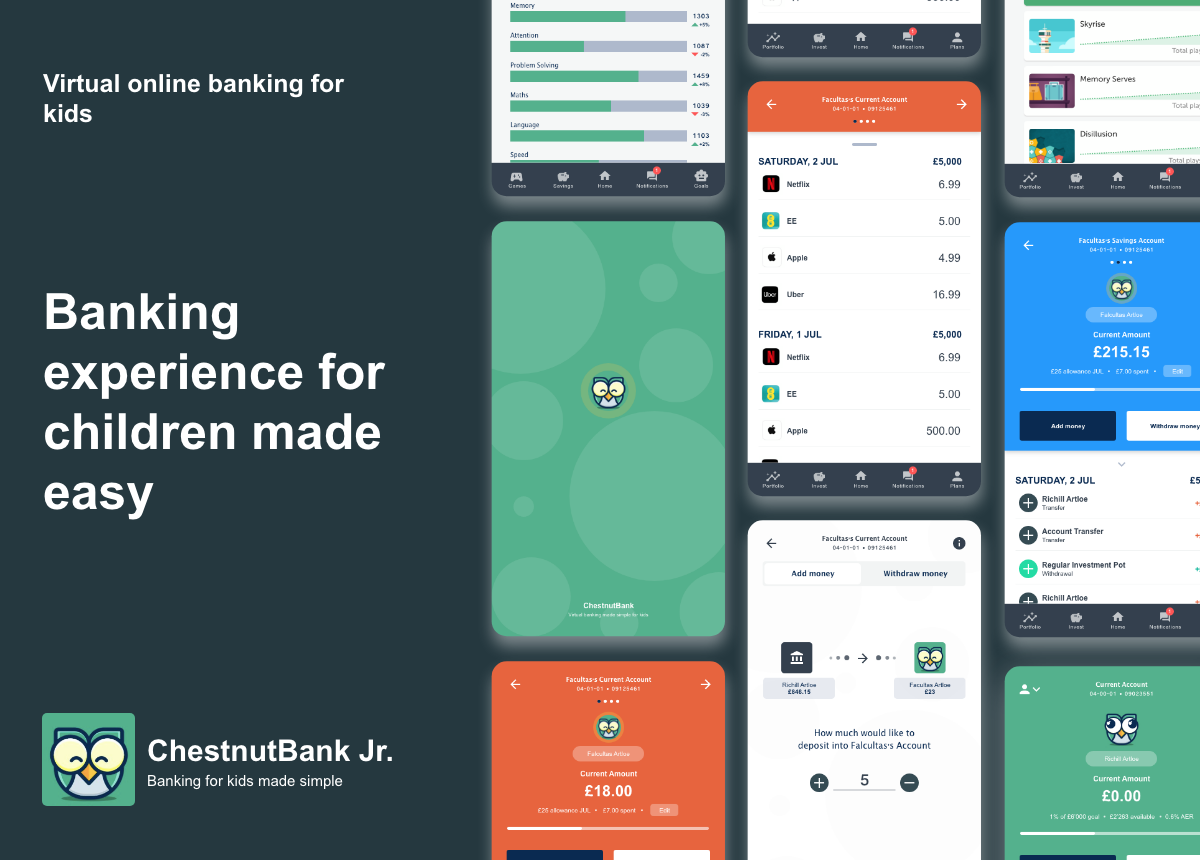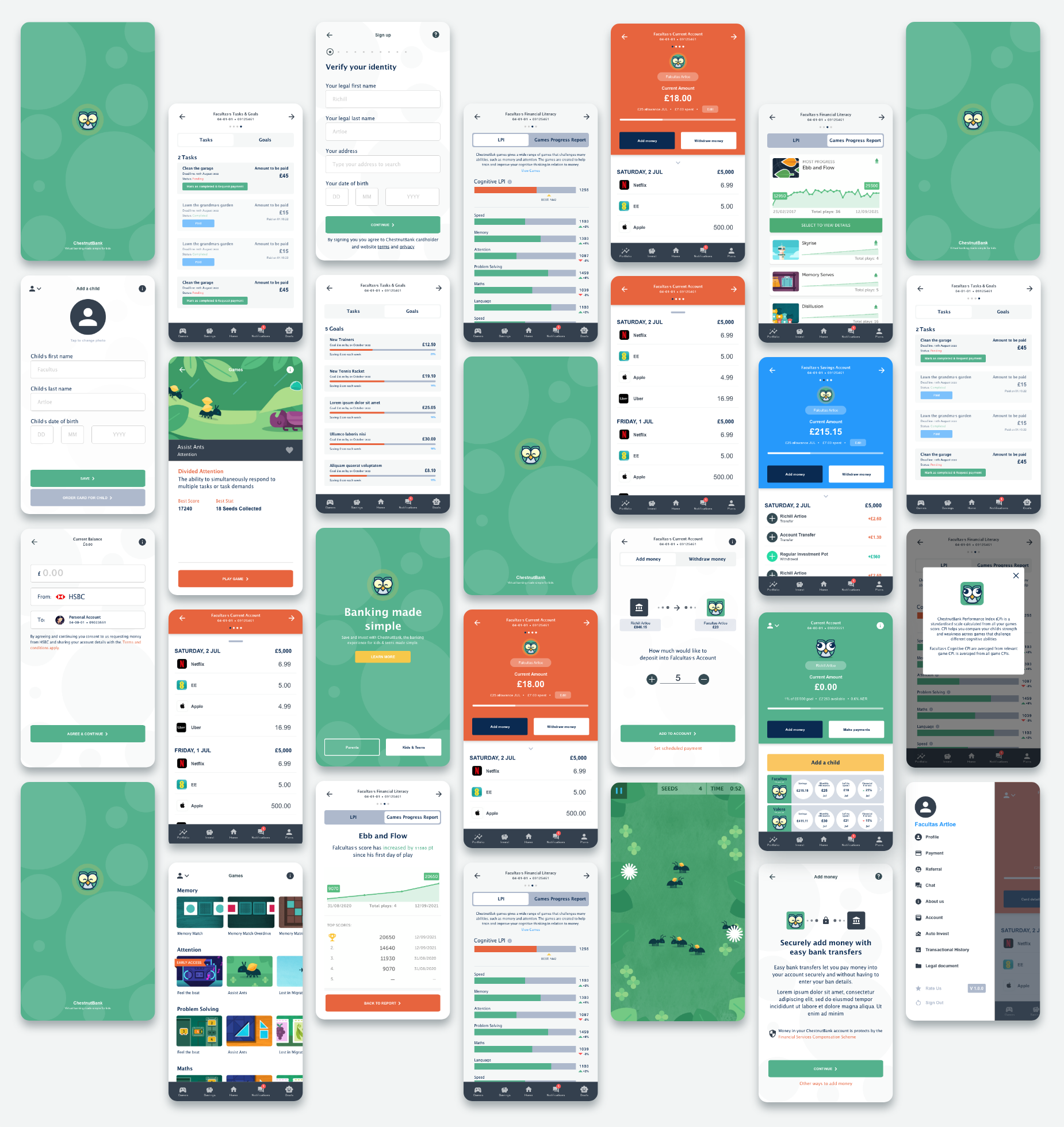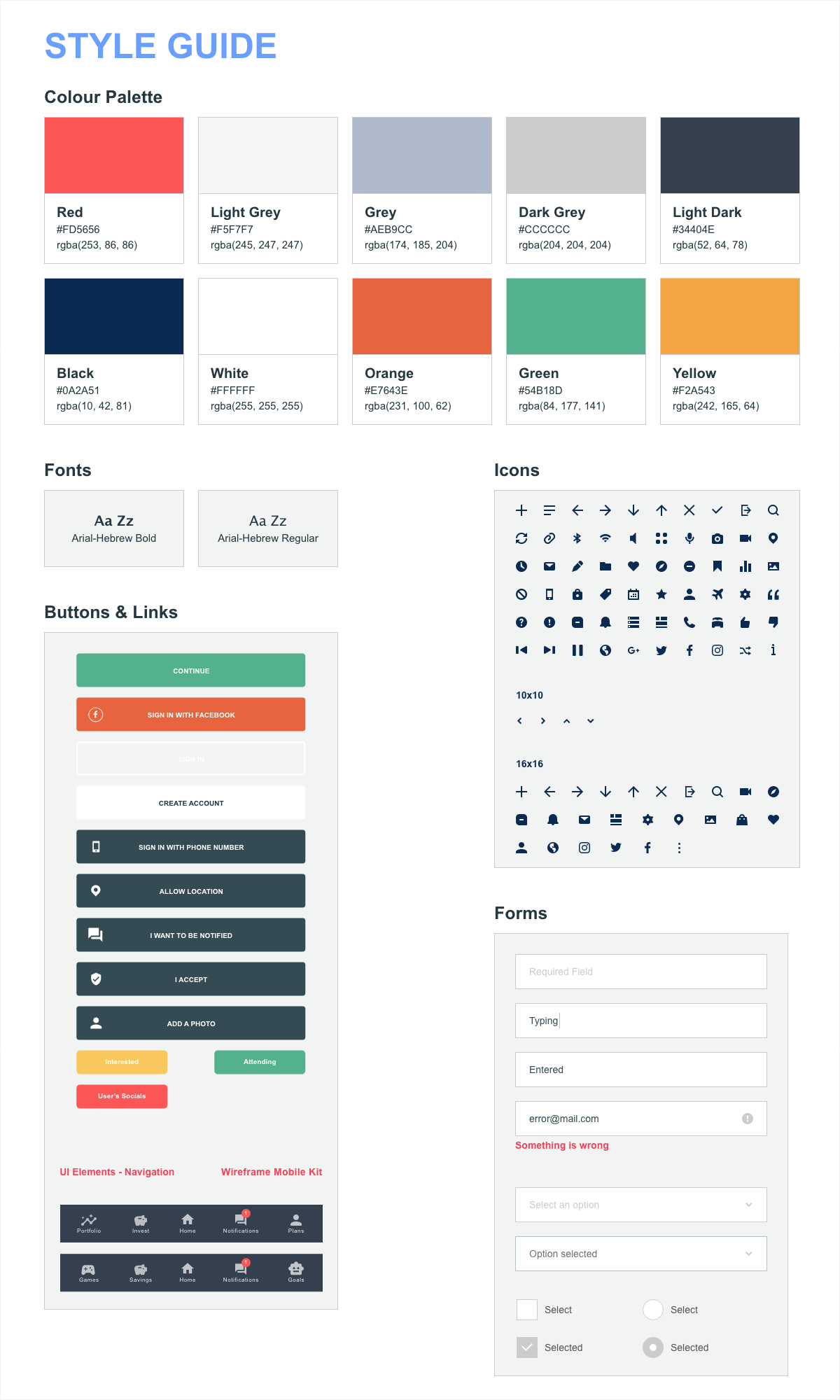|
client
|
Fintech App at ChestnutBank Jr. |
| sector | Finance , Investment , |
| project time | 5 days |
| my role | My role as a UX designer, was to research, analyse and address the potential problem a child between the age of 9-14 may face when it comes to being financially educated and to define the user experience based on findings using simple UI designs. This study takes into account the primary target users (children) of age 9-14 with guided access from the secondary target users (parents). |
| my contribution |
|
| services |
|
| team |
Richill ARTLoe(UX/UI Designer)
|
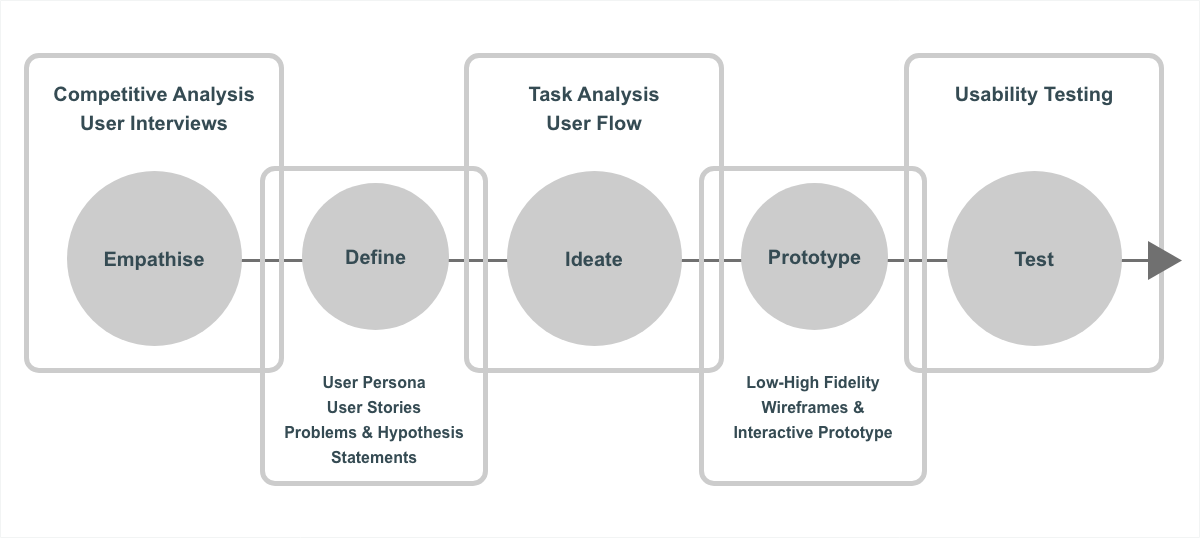
-
problem statement #1
 User's Experience - Problem Statement
User's Experience - Problem Statement
Akosua is a middle-aged working mother of two children. Akosua is 35 years of age and her children are of the ages 9 and 12. Akosua wants to invest in financially educating her children in their childhood in order to enable them to be financially knowledgable in their adults years so they can confidently make good investment decisions and save up effectively for their future. Akosua has little knowledge on how to find the best financial educational platform for her children. She is looking for an engaging platform that is fun, educational, simple, easy to use and that will motivate her children to increase their financial literacy.
Hypothesis
How might we support Akosua in finding the right virtual banking experience for her children? How can we provide both Akosua and her children with a financial experience that is easy, simple, accessible, and educational? For the financial app, we believe that, by creating a visually appealing app with a clean interface design and by refining the user experience by breaking down complex investment & saving process and data, we will achieve a way to allow Akosua to successfully increase the financial literacy of her children so they are able to have a good financial knowledge in heir adult years to make good investment decisions. We intend to help increase the financial literacy and banking experience of the children mainly through, (1) financial pop-up guidance and (2) a goal orientated gamification process, that is fun, simple and engaging for both the parent (Emma) and the children.
-
problem #1lack of a simplistic banking experience that is engaging & financially educational
The main challenge was to:
1. Engagement: Create a visually pleasing goal orientated gamification section that helped increased financial literacy & made learning interesting.
2. Trust: Improve user's trust with the app (both parent & child): offer some stats of financial literacy improvements & visually displaying successfully achieved financial goals and tasks.
3. Alert: Design/Build an alert/notification feature, that provides simplistic information on: daily financial literacy workouts, saving achievements, rewards etc -
solution #1Create a simplistic, easy, accessible, trustworthy & informative platform
How might we help Emma on her journey to educate her children financially in a fun engaging manner? The goal was to create a transparent, simplistic UX designed journey that was clear and frictionless. The main focus was on:
1. Engagement: AI Avatar - Gamification - goal orientated approach
2. Trust: Display evidence of child’s improvements & performance in a simplistic detailed way
3. Alerts: design notification alerts: Mobile alert → detailed info work outs & goals
-
sstrength
- Great for investment novices
- Automated savings features
- Flexible parental control
- Gamification via quizzes
-
wweakness
- No real time predicted investment balance & data update
- No statistical evidence of progressive learning
- Long cancellation & transfer process
- UI can be a little complicated for younger children
-
oopportunities
- Ability to create a niche in the financial investment market for kids - allows kids to invest in companies they can relate to eg: lego company
- Premium plans can expand popular features
- The opportunity to improve customer service
- Display of more investments that are appealing to children (kids may want to invest in companies they can relate to)
-
tthreats
- Strong competitors that offers similar products
- Design replication by financially strong competitors
- The fast progress and advancement of technology may raise the threat of the appearance of new rivals
- Meeting investment legislative requirements (investment section)
-
challenge #0Trust: Display statistical evidence of the child’s progress
Creating an engaging statistical platform that instantly displays financial literacy improvements to the parent. This in order to inform & help the parent on how best to guide their child’s financial literacy improvements. Also the provision of a financial assistance in a form of an avatar to guide the parents and better inform them on what educational content is best (in the tutorial process).
-
challenge #0Alerts: design a feature that nudges both child & parent of financial literacy improvements
Displaying and designing good UX/UI pop-ups & notifications that engages with both parent and child to meet their financial goals and also educates and informs them on different financial investment packages, investment performances, investment fees and tutorials. In this way, the experience of the app becomes more engaging, pleasant, transparent and less tiring.
-
challenge #0Engagement: creating a simplistic fun and visually pleasing goal gamification platform
Creating an engaging & easy-to-use financial gamification tutorial section where both child and adult can track financial literacy progress. Adding a reward system (in a form of finances & points) that motivates that the child to consistently engage in improving their financial knowledge.
-
challenge #0Tricky Investment Processes Made Complex
Not many financial apps are able to turn complex financial processes into an enjoyable experience, thereby leaving consumers feeling embarrassed, uncertain, annoyed & violated about their decisions & provided info. Creating a simplistic, informative user journey can help both child and parent easily view investment plans & setup financial goals. In this way, consumers are not subjected to complex processes.
-
challenge #0Lack of transparency regarding fees & Delayed Process In Transferring Funds during Cancellation
Takes long for funds to be transferred back to parent when account has been cancelled (7-10 working days). The process being very long, slow and daunting. This is one of the highly complained point/service by clients. Many complains regarding hidden fees.
-
challenge #0Lack Of Trustworthy Brand Appearance
A large majority of fintech apps and traditional banking institutions are generally viewed by consumers as distrustful. Therefore, it is important to focus on a Brand appearance that is appealing, with a clean, eye-catching, well-designed UX. This will hold consumers’ attention for longer, thereby winning their long-term trust.
-
interview questions #1interview Questions
Assuming the client already had a saving plan or would like to set up one for their child. The questions that were conducted were as below:
1. What is your age?
2. What is your relationship status?
3. how many children do you have?
4. select the age range of your child/children?
5. Do you currently have a savings plan for your child/children?
6. Is your child/children reasonably financially literate at their current age?
7. Do you use a virtual banking app for your child/children when managing their personal finances, for investing and creating financial goals?
8. What does your child/children find most engaging using these virtual banking apps?
9. Being able to educate your child financially, increase their financial knowledge & track their progress and investment decision at an early age, how does it make you feel?
10. If you currently use a banking app for your child, generally, how do you find the experience of using the financial investment?
11. As a parent, what will interest you most using a virtual banking app for your child/children?
-
survey questions #1Survey Questions
To get an idea of what parents felt and what they did about educating their child financially, a survey containing 10 questions was distributed to the targeted demographic; Middle age group between ages: 35 - 55 years, with children between the ages of 8 - 18.
The targeted groups were asked about their children’s financial literacy, their current savings and investment situation, their views on orientated financial goals, tasks & chores and if currently consulting an advisor or using applications to enabled them to educate their child effectively and learning about money, saving, investing and achieving financial goals.
-
key findings #0Lack of an engaging app that encourages parents to financial educate their child
One of the key findings within the survey was: the survey results showed majority of parents expressed concern over not having a savings plan for their children and that most children between the ages of 8 - 12 were not financially literate. The lack of an informative user friendly engaging virtual banking app resulted in parents not feeling encouraged and motivated to have the time to educate their child financially.
-
key findings #0Lack Of Transparent Fee info & educational improvement
Currently there is a lack of transparency: From the interview questions, not survey questions, responses showed users found transparency highly important. Parents were not getting solid clarity on their child’s financial literacy progress and felt they were being discreetly charged unnecessarily for using certain services of the app. An intensive research on competitors' trust-pilot reviews, showed a key finding, that clients did not feel they were well informed of the fee charges related to the usage of the app & fee related to selected investment.
-
key findings #0Minimal focus on gamification
The survey result showed parents found their child were more engaged in wanting to learn when there was a gaification section. Therefore the design was created to embed the app with engaging games that trained the mind of the users to be able to problem solve logical issues.
-
 "I Would Like To Gain More Confidence In The Financial Literacy Improvement Of My Child"Akosuaage: 35job: Nurseeducation: BSC (Hons) Nursingstatus: marriedAkosua is a middle-aged working professional, a mother of two children. Akosua is 35 years of age and her children are of the ages 9 and 12. Akosua wants to be able to feel confident in using a service that will progressively educate her children financially in their early years in order to enable them to be financially knowledgable in their adults years so they can confidently make good investment decisions and save up effectively for their future.goalsTo create a financially secure future for her childrenTo ensure her children are more financially literateTo feel confident in guiding her children’s financial pathtasksResearch a platform that financially educates her childrenCompare fees of virtual banking apps for kidsTeach and in-still saving habits & value in childrenFrustrationsUnable to track financial literacy performanceHer children tend to overspendBusy-doesn’t have time to financially educate her kidshow ChestnutBank Jr. helpsProvides chore request/tracker availableProvides zero fees on transfersProvides detailed stats on child’s literacy progress
"I Would Like To Gain More Confidence In The Financial Literacy Improvement Of My Child"Akosuaage: 35job: Nurseeducation: BSC (Hons) Nursingstatus: marriedAkosua is a middle-aged working professional, a mother of two children. Akosua is 35 years of age and her children are of the ages 9 and 12. Akosua wants to be able to feel confident in using a service that will progressively educate her children financially in their early years in order to enable them to be financially knowledgable in their adults years so they can confidently make good investment decisions and save up effectively for their future.goalsTo create a financially secure future for her childrenTo ensure her children are more financially literateTo feel confident in guiding her children’s financial pathtasksResearch a platform that financially educates her childrenCompare fees of virtual banking apps for kidsTeach and in-still saving habits & value in childrenFrustrationsUnable to track financial literacy performanceHer children tend to overspendBusy-doesn’t have time to financially educate her kidshow ChestnutBank Jr. helpsProvides chore request/tracker availableProvides zero fees on transfersProvides detailed stats on child’s literacy progress -
 "I would like to see more less complex investment opportunities tailored for my child"Michaelage: 41job: Accountanteducation: ACCAstatus: divorcedMicheal is a middle-aged professional working in the UK, a single father of an 11 year old child. Michael is looking for an investment platform that easy, less complex and simple for his child. Micheal wants to secure a savings plan for his child through financially educating him in saving, investing, managing and spending money wisely. Micheal would like to view less complex investment opportunities tailored for his son (eg: investing in lego). He is looking for a trustworthy plan, that is accessible and easy, which will support him and his son in making a good investment and saving up for the future.goalsTo start a savings plan for his sonResearch profitable investments with sonTeach child to be financially disciplinedtasksKeeping track of child’s finances & investmentResearch great investment packages for kidsTeach and in-still saving habits & value in childrenFrustrationsInvestment process too complex for childUnable to track child’s finances & investmentBusy-doesn’t have time to financially educate his kidhow ChestnutBank Jr. helpsProvides basic interactive Chatbot to guide financiallyProvides investment packages tailored for kidsProvides detailed stats on child’s literacy progress
"I would like to see more less complex investment opportunities tailored for my child"Michaelage: 41job: Accountanteducation: ACCAstatus: divorcedMicheal is a middle-aged professional working in the UK, a single father of an 11 year old child. Michael is looking for an investment platform that easy, less complex and simple for his child. Micheal wants to secure a savings plan for his child through financially educating him in saving, investing, managing and spending money wisely. Micheal would like to view less complex investment opportunities tailored for his son (eg: investing in lego). He is looking for a trustworthy plan, that is accessible and easy, which will support him and his son in making a good investment and saving up for the future.goalsTo start a savings plan for his sonResearch profitable investments with sonTeach child to be financially disciplinedtasksKeeping track of child’s finances & investmentResearch great investment packages for kidsTeach and in-still saving habits & value in childrenFrustrationsInvestment process too complex for childUnable to track child’s finances & investmentBusy-doesn’t have time to financially educate his kidhow ChestnutBank Jr. helpsProvides basic interactive Chatbot to guide financiallyProvides investment packages tailored for kidsProvides detailed stats on child’s literacy progress -
 "I feel the only way i can learn more about money is if there are more fun games on the app"Alvinage: 10job: Studenteducation: Student (Primary 4)status: n/aAlvin is a young primary 4 student. Alvin Loves games and sports especially football. Alvin is keen on learning new stuff on saving money with the support of his parent and with some good encouragement from the app. Aside from learning how to save and invest, Alvin would mainly like to see more interesting games on the platform, interesting game over chores and task that would get him financially rewarded by his parents do he can grow his virtual piggy ban account. In conclusion Alvin would like to be able to easily check his balance, track his spending and save some money.goalsSave up enough money for new football shoesIncrease piggy bank money via gamesHang out with friends and buy snackstasksGet financially rewarded via gamesSave money to purchase items he needsBe less dependent on allowances from parentsFrustrationsLoses track of money allowance from parentsReliant consistently on parents for moneyCan’t find engaging gameshow ChestnutBank Jr. helpsProvides financial independence/Prepaid cardProvides engaging financially rewarding gamesProvide allowance & spending tracker
"I feel the only way i can learn more about money is if there are more fun games on the app"Alvinage: 10job: Studenteducation: Student (Primary 4)status: n/aAlvin is a young primary 4 student. Alvin Loves games and sports especially football. Alvin is keen on learning new stuff on saving money with the support of his parent and with some good encouragement from the app. Aside from learning how to save and invest, Alvin would mainly like to see more interesting games on the platform, interesting game over chores and task that would get him financially rewarded by his parents do he can grow his virtual piggy ban account. In conclusion Alvin would like to be able to easily check his balance, track his spending and save some money.goalsSave up enough money for new football shoesIncrease piggy bank money via gamesHang out with friends and buy snackstasksGet financially rewarded via gamesSave money to purchase items he needsBe less dependent on allowances from parentsFrustrationsLoses track of money allowance from parentsReliant consistently on parents for moneyCan’t find engaging gameshow ChestnutBank Jr. helpsProvides financial independence/Prepaid cardProvides engaging financially rewarding gamesProvide allowance & spending tracker
-
insight #0participants: 10age range: 10 - 44performed with: AdobeXD, desktop
Research from both the quantitative and qualitative side took place. The main goal was to:
1. Understand the user experience and journey when creating savings & investment plan for a child
2. Understand the progressive learning of a child when it comes to savings, investing and learning financially
3. Understand how the user engaged with a more user friendly designed app
4. Understand the user experience, journey and decision making when searching for the right investment package for a child
5. Understand the relevance of the tracker (both learning & spending) for parents
6. Understand the progressive learning of a child when it comes to savings, investing and learning financially
7. Understand the relevance of the engagement in regards to gamification - does this enable progressive learning? is it a relevant demand?
8. Analyse the user's journey experience in making use of the pop-up financial guide and information
This would help us to better identify important feature requirements of potential users.Analysis - Findings From Interviews & Survey: After studying the user personas and stories, analysing their pain points and goals, thisThe expanded conclusions from the analysed survey were:
1. Parents want to receive to form of notifications whenever there is an activity or transaction on the app
2. Parents will like additional control of not only providing/adding allowance but be able to deduct funds
3. Parents would like to be able to limit expenditure
4. Parents would like to be able to track child’s financial literacy progression & spenditure
5. Child would like an animated engaging piggy bank/account -
insight #0goal:
The goal was to test and identify the user's pleasure and pain experience:
1. while tracking their children expenditure and allowance
2. while searching or selecting a suitable profitable investment package tailored for their kids
3. while engaging with games that encourages financial literacyThe prototype test will aim to highlight any usability issues and define the usefulness of mainly the tracking system & the gamification aspects of the app, whiles observing the user completing basic tasks and functions. We even went one step further to create a design that gave users the opportunity to try the app and it’s services for free. The design goal was, to design an app that gave them confidence in securing their child’s future financially & advancing their child’s financial literacy.
task:1. create an account
2. complete registration (both child & parent)
3. create financial goals, task & chores
4. invest in a financial package & create a saving plan for the child
5. engagement: view & interact with stats on prototype (stats & gamification)
-
insight #0results:
1. 65% of user testers had a smooth user journey experience
2. 70% of user testers found the process of guiding their child to manage, save and invest a smooth journey
3. 68% of users had a smooth experience in being highly financially educated & informed of their child’s progressUsers needed time to build trust with the app first. To establish that trust, we turned the process inside-out: Allow users to try the app and when ready to to use the services of the app. In this way, users were given the opportunity to build rapport with the app.
observations:1. Users were pleased with the simplified, less time consuming process of using the app
2. Users felt the financial pop-ups could be more informative
3. Users were pleased with the detailed information provided on their child’s literacy performance
4. Users wanted some form of notification with stats details, when their investment were doing quite well above the norm
5. User took a liking to the gamification section as they could see this could potentially improve child’s performance with the detail stats on the financial education progress
6. over 50% of users found the design of the app very pleasingThe main takeaway was, it's important to create some form of active communication between the parent & the child regarding the process in managing, saving & investing as well as learning regardless of whether the child’s was progressing or not or whether the selected investment was progressing was doing well or not.
The primary goal of the case study was to develop an app that had a great user journey/experience flow to initiate an increase in its engagement. The finTech app had to be designed for children between the ages of 9 - 14, to help guide them to manage, save and invest. I played an essential part in creating the UX/UI Design to enable the project to achieve it's main goals. This was achieved by improving the below user experience and customer satisfaction features, that were to ultimately help parents guide and monitor their child’s progress in managing money on the app. The main goals achieved were:
1. smooth onboarding experience
2. quick registration process
3. add gamification features for engagement (encouraging financial literacy learning)
4. provide informative & educational financial notes during the savings & investment process
5. friendly engaging platform
6. simplistic informative stats on on child’s progress in managing funds
7. smooth payment & subscription journey flow
The information architecture, interaction design, usability, wire-framing and visual designs were all created for the case study.
-
challenge #0The importance of gamification leading to engagement
The research showed that parents were able to identify their child’s interest for discovery through games, unfortunately these games were most times not educational. In conclusion, based on research it was decided to turn the user experience of the child into playing a game which we aimed to significantly increase the child’s engagement in learning and encourage them to interact with the app more often. The possibility of winning influences the user's behaviour even more than we can imagine and providing stats on child’s progressive cognitive learning will enable parents to be more engaged with the app
-
challenge #0Fintech Apps for kids don’t Have To Be Boring
During the competitive analysis of other apps in the fintech space, it was clear most of them had bland colour palettes and uninviting experiences. Investing is hard enough, so a conscious effort was made to keep things simple, both for process and interaction. Subsequently, the visual design turned out wildly different compared to other fintech tools.
-
challenge #0Simplifying The Complex Investment Processes
Financial apps are seemingly at a disadvantage because of regulatory and legal requirements. Until recently, this led to poorly designed apps features and processes. Most still lack the clean interface design and refined user experiences. There was a lot to learn in creating better defined, smarter experiences that addresses the user needs. This design was risky but paid off due to its clear and simple user experience.



